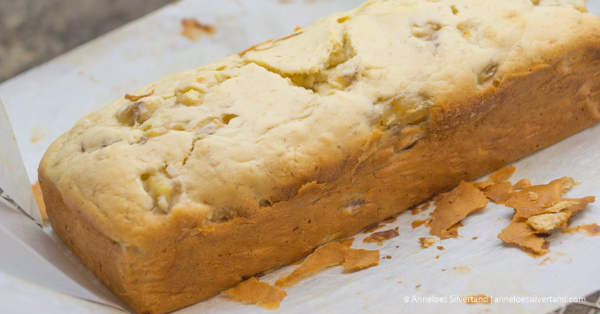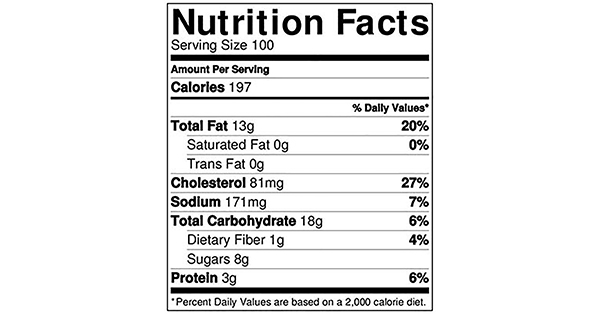A tender and moist Banana Bread that combines the sweet taste of bananas with the pleasant texture of good bread. Before making this bread, it is a good idea to check out my [Tips for making Cakes]. This will help you make the perfect cakes and could fix some problems you might have encountered, on your baking adventures!

If you have any dietary restrictions, always check the labels on the products you are using to make this recipe with. They will tell you if, for instance, your ingredient might contain traces of nuts, your products are made with dairy or if there is a chance the ingredients have come into contact with gluten-containing food or equipment.
Would you like to know more about what to look for when you are buying your products while you have dietary restrictions or preferences? Are you preparing food for someone who does? Check out my articles on [Food and Health] and learn more!
Do you like the Banana Bread recipe? Please share it or leave a comment and follow Truthful Food on social media so that you won’t miss out on anything new and delicious!
Ingredients
- 100 g Coconut Butter
- 2 Chicken Egg [Size L] - [See good to know section.]
- 50 g Honey - [See good to know section.]
- 60 g Low-Fat Cow’s Milk - [See good to know section.]
- 2 Banana - [See good to know section.]
- 250 g All-Purpose Wheat Flour
- 10 g Baking Powder
Other things you need
- Food Scale
- Mixer
- Spatula - Ideally a silicone spatula.
- Bowl
- Parchment Paper
- Baking Tin [25 cm or 10”] - [See good to know section]
- Oven
- Oven Mitts
- Cooling Rack - This is optional.
Instructions
- Preheat the oven to 175 degrees Celsius or 350 degrees Fahrenheit.
- Weigh your ingredients.
- Put the flour, baking powder, and coconut butter in a bowl and mix at low speed.
- Add the honey, the eggs, and the milk and mix the batter till it is smooth.
- Cut the bananas into small pieces and mix them into the batter.
- Take your baking tin and line it with parchment paper. How? [Check out my article and video!]
- Pour the batter into the baking tin and put it in the oven for at least 40 minutes. If you are using the recommended baking tin size, the baking time is about 50 minutes.
- Check if your bread is ready before you take it out of the oven. How? [Check out my article!]
- Let the Banana Bread cool down a little and enjoy!
Good to know
- Storing: Make sure to store your bread in an airtight container if you are not eating all of it right away. Keep in mind that this bread has a short shelf life and should ideally be eaten on the day you bake it.
- Shelf life: Your bread will stay good for several days if stored correctly. The bread tastes best when eaten within two days. After two days it will be noticeably dryer.
- Freezing: You can freeze your bread in an air-tight container or freezer bag and it will stay good for several weeks. You can thaw your bread in the microwave but it will taste best if you let it thaw slowly at room temperature.
- Adding dry ingredients: If you have the patience, it pays off to sieve the dry ingredients while you are adding them. It will ensure you do not end up with lumps in your batter.
- Adding flour: To make sure you don’t over-mix or damage the structure of the batter when adding the flour, you can use a whisk to mix it in bit by bit.
- Refrigerating: I do not recommend storing the batter in your refrigerator for later use. Most leavening agents (baking powder, baking soda etc.) you are using to make the batter rise, will start doing their job right after you add them. That means that your batter will start to rise while still in the refrigerator instead of in the oven and you will end up with a flat bread.
- Lining the baking tin: If you do not want to line your baking tin with parchment paper, you don’t have to. Make sure it is very clean on the inside. Spray the inside of the tin with cooking spray before you put the batter in the tin so the cake can be removed easily when it is done.
- Baking time: Depending on what kind of baking tin you use, the baking time will vary. Check what baking tin is recommended in your recipe and adjust accordingly. The tin-to-batter-ratio you choose influences the baking time greatly. If you are using an oven, recipe and/or baking tin for the first time, make sure to keep a close eye on the progression of your bread. Check out my Tips and Tricks for baking a cake on the articles page for more useful information!
- Cooling down: Ideally, you should let your bread cool down on a cooling rack. If you do not have one, let the bread cool down on a piece of parchment paper so it will be easy to move after it has cooled down.
- Your oven: When you are trying out a new recipe, it is possible that your oven requires a slight change in baking time or temperature settings. Do not get discouraged if things do not turn out as you had hoped right away. Check out my articles on Oven Temperature Settings and find out what went wrong!
- Using fruit: When working with fruit, make sure it is ripe and washed when you use it.
- Cutting the bread: Do not cut your bread until after it has cooled down considerably. The bread will crumble if you do not wait long enough.
- Using eggs: Make sure your eggs are still good before you use them. How? [Check out my article!]
- Organic: To make this recipe organic, only use organic ingredients.
- Lactose-free: Use lactose-free milk.
Nutritional Information per Portion
Know What You Eat
Both when buying food or when making your own, it is important to inform yourself about the nutritional value. Have a look at the nutrition label, learn about your serving size and what nutrients this product will bring to the table.
If you want to compare different products and their values, it is easier to look at a label where the values are given per 100 grams. This way you get a better understanding of the categories certain products belong to when it comes to nutritional values. Is this a product with a high sugar content? Does it contain a lot of fibre? How does this product measure up if I am looking to stick to a low-sodium diet?

Keep in mind that if you are looking to eat healthily, you should not just avoid eating fat and/or sugar. We need both in our daily diet. Make sure however to be aware of where you get your lipids and sugars from. As a rule of thumb, you could say; variation is very important in your diet and in general, the closer your food is to come straight from the source, the better.
If you want to read more about healthy food choices, [check out my article]. Truthful Food also has a continuously growing article category solely focusing on specific ingredients and nutrients for everyone who wants to take a closer look at what you can find in your food.
*All given nutritional information is an indication. Due to differences in how ingredients are produced, where they are purchased and how the recipe is prepared, nutritional values may vary.
Leave a Reply